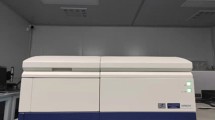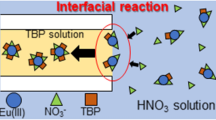Abstract
Solvent property of air–water interface was evaluated based on the fluorescence spectra of 1,2′-dinaphthylamine in water containing ultrafine bubbles (average diameter: 103 nm, standard deviation: 38 nm). Among naphthylamine derivatives whose fluorescence spectra were responsive to microscopic hydrophobicity, 1,2′-dinaphthylamine (DN) was selected because its wavelength of the maximum emission (λmax) was significantly dependent on the concentration and microenvironment of the ultrafine bubble. The λmax value of DN in water was 486 nm, while it shifted to shorter wavelength (408 nm) in the presence of 1.09 × 109 mL−1 of ultrafine bubbles. The shift of λmax value indicates that DN adsorbs on the surfaces of ultrafine bubbles and exists in hydrophobic region rather than in bulk water. By comparing with the λmax values in different solvents, the surface of ultrafine bubble was found to have similar solvent property to ethyl ether or ethyl acetate that are widely used as extracting solvents for hydrophobic organic compounds.
Graphical abstract




Similar content being viewed by others
Data availability
The results of this study may provide quantitative information on the area of the air-water interface or the volume of the interfacial region, which is useful for the use of ultrafine bubbles as a reaction medium.
References
H. Mohwald, Phospholipid and phospholipid-protein monolayers at the air/water interface. Annu. Rev. Phys. Chem. 41, 441–476 (1990). https://doi.org/10.1146/annurev.pc.41.100190.002301
H.M. McConnell, Structures and transitions in lipid monolayers at the air-water interface. Annu. Rev. Phys. Chem. 42, 171–195 (1991). https://doi.org/10.1146/annurev.pc.42.100191.001131
C.H. Chang, E.I. Franses, Adsorption dynamics of surfactants at the air/water interface: a critical review of mathematical models, data, and mechanisms. Colloid Surf. A Physicochem. Eng. Aspects 100, 1–45 (1995). https://doi.org/10.1016/0927-7757(94)03061-4
J. Eastoe, J.S. Dalton, Dynamic surface tension and adsorption mechanisms of surfactants at the air-water interface. Adv. Colloid Interface Sci. 85, 103–144 (2000). https://doi.org/10.1016/S0001-8686(99)00017-2
H. Wang, E. Borguet, K.B. Eisenthal, Polarity of liquid interfaces by second harmonic generation spectroscopy. J. Phys. Chem. A 101, 713–718 (1997). https://doi.org/10.1021/jp9806563
H. Wang, E. Borguet, K.B. Eisenthal, Generalized interface polarity scale based on second harmonic spectroscopy. J. Phys. Chem. B 102, 4927–4932 (1998). https://doi.org/10.1021/jp9806563
S. Sen, S. Yamaguchi, T. Tahara, Different molecules experience different polarities at the air/water interface. Angew. Chem. Int. Ed. 48, 6439–6442 (2009). https://doi.org/10.1002/anie.200901094
K. Kodama, M. Oiwa, T. Saitoh, Purification of rhodamine B by alcohol-modified air bubble flotation. Bull. Chem. Soc. Jpn 94, 1210–1214 (2021). https://doi.org/10.1246/bcsj.20200395
K. Kodama, T. Saitoh, Surfactant-free air bubble flotation–coagulation for the rapid purification of chloroquine. Anal. Sci. 39, 43–49 (2022). https://doi.org/10.1007/s44211-022-00196-2
K. Kodama, N.T.T. Thao, T. Saitoh, Effect of air bubbles on the membrane filtration of rhodamine B. Anal. Sci. (2023). https://doi.org/10.1007/s44211-023-00366-w
K. Terasaka, K. Yasui, W. Kanematsu, N. Aya, Ultrafine bubbles (Jenny Stanford Publishing, New York, 2021).https://doi.org/10.1201/9781003141952
S. Tanaka, Y. Naruse, K. Terasaka, S. Fujioka, Concentration and dilution of ultrafine bubbles in water. Colloids Interfaces 4, 50 (2020). https://doi.org/10.3390/colloids4040050
D. Nieva-Gomez, J. Konisky, R.B. Gennis, Membrane changes in Escherichia coli induced by colicin Ia and agents known to disrupt energy transduction. Biochemistry 15, 2747–2753 (1976). https://doi.org/10.1021/bi00658a006
S. Ozeki, K. Tejima, Drug interactions. V. Binding of basic compounds to bovine serum albumin by fluorescent probe technique. Chem. Pharm. Bull. 27, 638–646 (1979). https://doi.org/10.1248/cpb.27.638
E.G. Sedgwick, P.D. Bragg, Distinct phases of the fluorescence response of the lipophilic probe N-phenyl-1-naphthylamine in intact cells and membrane vesicles of Escherichia coli. Biochim. Biophys. Acta 894, 499–506 (1987). https://doi.org/10.1016/0005-2728(87)90129-0
R.M.M. Brito, W.L.C. Vaz, Determination of the critical micelle concentration of surfactants using the fluorescent probe N-phenyl-1-naphthylamine. Anal. Biochem. 152, 250–255 (1986). https://doi.org/10.1016/0003-2697(86)90406-9
T. Saitoh, K. Taguchi, M. Hiraide, Evaluation of hydrophobic properties of sodium dodecylsulfate/γ-alumina admicelles based on fluorescence spectra of N-phenyl-1-naphthylamine. Anal. Chim. Acta 454, 203–208 (2002). https://doi.org/10.1016/S0003-2670(01)01575-6
T. Saitoh, K. Shibata, M. Hiraide, Rapid removal and photodegradation of tetracycline in water by surfactant-assisted coagulation-sedimentation method. J. Environ. Chem. Eng. 2, 1852–1858 (2014). https://doi.org/10.1016/j.jece.2014.08.005
T. Saitoh, T. Shibayama, Removal and degradation of β-lactam antibiotics in water using didodecyldimethylammonium bromide-modified montmorillonite organoclay. J. Hazard. Mater. 317, 677–685 (2016). https://doi.org/10.1016/j.jhazmat.2016.06.003
P. Jungwirth, D.J. Tobias, Ions at the air/water interface. J. Phys. Chem. B 106, 6361–6373 (2002). https://doi.org/10.1021/jp020242g
P. Jungwirth, D.J. Tobias, Specific ion effects at the air/water interface. Chem. Rev. 106, 1259–1281 (2006). https://doi.org/10.1021/cr0403741
Y. Rao, M. Subir, E.A. McArthur, N.J. Turro, K.B. Eisenthal, Organic ions at the air/water interface. Chem. Phys. Lett. 477, 241–244 (2009). https://doi.org/10.1016/j.cplett.2009.07.011
F.Y. Ushikubo, T. Furukawa, R. Nakagawa, M. Enari, Y. Makino, Y. Kawagoe, T. Shiina, S. Oshita, Evidence of the existence and the stability of nano-bubbles in water. Colloids Surf. A Physicochem. 361, 31–37 (2010). https://doi.org/10.1016/j.colsurfa.2010.03.005
W. Kanematsu, T. Tuziuti, K. Yasui, The influence of storage conditions and container materials on the long term stability of bulk nanobubbles—consideration from a perspective of interactions between bubbles and surroundings. Chem. Eng. Sci. 219, 115594 (2020). https://doi.org/10.1016/j.ces.2020.115594
X. Zhang, Q. Wang, Z. Wu, D. Tao, An experimental study on size distribution and zeta potential of bulk cavitation nanobubbles. Int. J. Miner. Metall. Mater. 27, 152–161 (2020). https://doi.org/10.1007/s12613-019-1936-0
S. Tanaka, K. Terasaka, S. Fujioka, Generation and long-term stability of ultrafine bubbles in water. Chem. Ing. Tech. (Weinh) 93, 168–179 (2021). https://doi.org/10.1002/cite.202000143
B.H. Tan, H. An, C.-D. Oh, Stability of surface and bulk nanobubbles. Curr. Opin. Colloid Interface Sci. 53, 101428 (2021). https://doi.org/10.1016/j.cocis.2021.101428
Acknowledgements
This study was supported by a Grant-in-Aid for Scientific Research (B) (22H02115). The authors are very grateful to Mr. Takuya Iwata (Nagoya University) for his kind support for the measurements of UFB.
Author information
Authors and Affiliations
Corresponding author
Rights and permissions
Springer Nature or its licensor (e.g. a society or other partner) holds exclusive rights to this article under a publishing agreement with the author(s) or other rightsholder(s); author self-archiving of the accepted manuscript version of this article is solely governed by the terms of such publishing agreement and applicable law.
About this article
Cite this article
Kodama, K., Hattori, S., Yasuda, K. et al. Evaluation of solvent property of air–water interface based on the fluorescence spectra of 1,2′-dinaphthylamine in the aqueous solution of ultrafine bubbles. ANAL. SCI. 40, 341–345 (2024). https://doi.org/10.1007/s44211-023-00454-x
Received:
Accepted:
Published:
Issue Date:
DOI: https://doi.org/10.1007/s44211-023-00454-x




